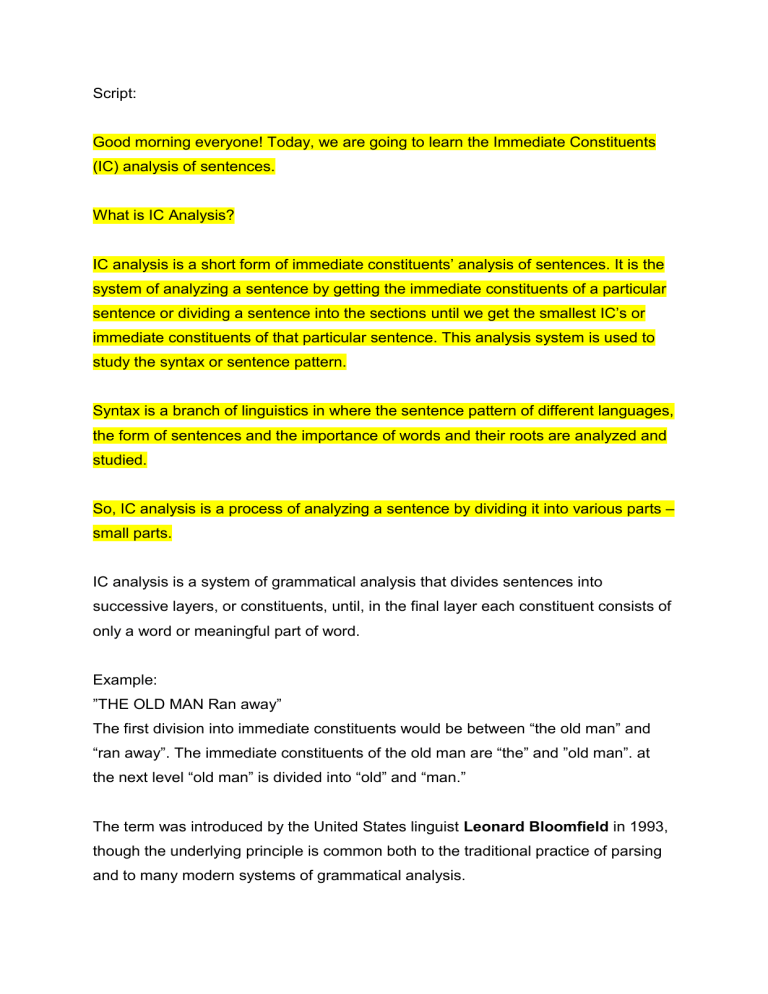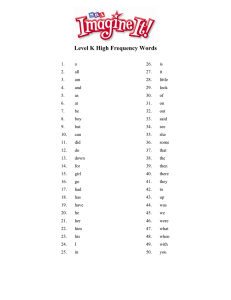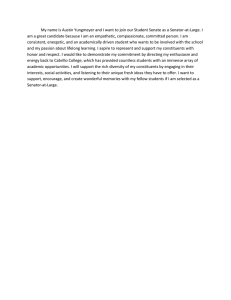
Script: Good morning everyone! Today, we are going to learn the Immediate Constituents (IC) analysis of sentences. What is IC Analysis? IC analysis is a short form of immediate constituents’ analysis of sentences. It is the system of analyzing a sentence by getting the immediate constituents of a particular sentence or dividing a sentence into the sections until we get the smallest IC’s or immediate constituents of that particular sentence. This analysis system is used to study the syntax or sentence pattern. Syntax is a branch of linguistics in where the sentence pattern of different languages, the form of sentences and the importance of words and their roots are analyzed and studied. So, IC analysis is a process of analyzing a sentence by dividing it into various parts – small parts. IC analysis is a system of grammatical analysis that divides sentences into successive layers, or constituents, until, in the final layer each constituent consists of only a word or meaningful part of word. Example: ”THE OLD MAN Ran away” The first division into immediate constituents would be between “the old man” and “ran away”. The immediate constituents of the old man are “the” and ”old man”. at the next level “old man” is divided into “old” and “man.” The term was introduced by the United States linguist Leonard Bloomfield in 1993, though the underlying principle is common both to the traditional practice of parsing and to many modern systems of grammatical analysis. Immediate constituent analysis was developed further by Rulon Wells. The process reached a full-blown strategy for analyzing sentence structure in the early works of Noam Chomsky. Most tree structures employed to represent the syntactic structure of sentences are products of some form of IC-analysis The process and result of IC-analysis can, however, vary greatly based upon whether one chooses the constituency relation of phrase structure grammar (= constituency grammars) or the dependency relation of dependency grammars as the underlying principle that organizes constituents into hierarchical structures. When we say Phrase structure grammar it is a type of generative grammar in which constituent structures are represented by phrase structure rules or rewrite rules. And Dependency grammar is a descriptive and theoretical tradition in linguistics that can be traced back to antiquity. It has long been influential in the European linguistics tradition and has more recently become a mainstream approach to representing syntactic and semantic structure in natural language processing. IC is based on the notion that a sentence is just not a linear string of word but a sequence of components or group or words. These group of words are called “constituents” When they are joined by horizontal line, they are said to be in ‘construction’ with each other. The construction established relationship between the constituents. When these constituents are considered as part of successive (next) unraveling (showing) of a sentence, they are called immediate constituents (next element of a sentence). Thus, a sentence is cut into two parts and again into two parts. This is continued until the smallest unit or morpheme is arrived. In the sentence, “A young girl with an umbrella chased the boy”. First, we can divide the sentence into two, “A young girl with an umbrella” as the first section, and “chased the boy” will be the another section of the sentence. These two section can be divided again like, ”a young girl” and “with an umbrella”. Same goes to the other section, we have, “chased” and “the boy”. Now, we can also divide “a young girl” into “a” and “young girl” and “with an umbrella” to “with” and “an umbrella”. However, on the other section “chased” we cannot divide a word “chased” further, we can divide in the sense of the word. “Chased” there is the past form of the verb because of the suffix -d attach to it. So we can divide it by mentioning the present form of the verb which is “chase” and instead of writing suffix -d, we can mention here the tense of the verb that is in the past form of the verb. And “the boy” we can divide by making “the” and “boy”. A “young girl” and “an umbrella” can be divided into another section like this, “young” and “girl” also “an” and “umbrella”. On this way, the sentence was divide into immediate constituents. The words “A”, “young”, “girl”, “with”, “an”, “umbrella”, “chase”, “the” and “boy” is the constituents of the sentence “A young girl with an umbrella chased the boy”. We cannot divide further the remaining words or it is impossible to divide the remaining words because we already got the smallest constituents of the sentence. This sentence was analyzed using the basic purpose of this method and by using the tree diagram. But actually, the other way of showing the constituents are with vertical lines and brackets. Like this, One of the limitations of the IC-analysis is that, it does not indicate the nature and grammatical functions of the constituents. To remove the inadequacy, the idea of labeling was introduced by Mak Halliday. These labels are two types – Class labels and Function labels. Class labels are NP-noun phrase, VP-verb phrase, A-article, Adj.-Adjectives, etc. Functions labels are S-Subject, V-verb , O-object, etc. Example, in the sentence “Poor John ran away”. By using IC analysis, again, we divide the sentence into two section, which are “Poor John” and “ran away”. “Poor John” and “ran away” there is the immediate constituents of the whole sentence. By using labeling, the first section “Poor John” can be labelled as a noun phrase. An “ran away” there can be labelled as the verb phrase”. The labels “NP” or Noun Phrase and “VP or Verb Phrase” usually called the nodes. Next to get the IC of the two sections, we again divide each section. “Poor John” can be divided into “poor” which labeled as adjective and “John” labeled as noun. The other section can be divided into “ran” which is labeled verb, sorry for the typographical error, and away labeled as adverb. Understand classmates? So for the limitations of IC-analysis we have, • First, it cannot analyze structure which do not form proper grammatical groups. For example, ‘She is taller than her sister’, here, ‘-er’ and ‘than’ cannot be explained properly. • Ambiguous sentences cannot be analyzed adequately. For example, ‘Time flies’. • An overlapping also causes a problem for IC-analysis. For example, ’He has no interest in music’. • Finally, an element remains unstated in sentences like ‘Hit the ball’. For the conclusion, IC-analysis remains an established method of describing the sentence elements. In summary my dear classmates, Immediate constituent analysis is a form of linguistic review that breaks down longer phrases or sentences into their constituent parts, usually into single words. This kind of analysis is sometimes abbreviated as IC analysis, and gets used extensively by a wide range of language experts. This kind of exploration of language has applications for both societal or traditional linguistics, and natural language processing in technology fields. For those who use this kind of analysis to examine text or speech, immediate constituent analysis often requires separating parts of a sentence or phrase into groups of words with semantical synergy or related meaning. For example, the sentence, “the car is fast,” could be broken down into two groups of words: “the car” and “is fast.” In this case, the first group contains an article applied to a noun, and the second group contains a verb followed by a defining adjective. Many kinds of immediate constituent analysis include multi-step processing. For the example, the two groups of words “the car” and “is fast” could be split up further into individual words such as, “the”, “car”, “is” and “fast”. Reviewers might consider how the article “the” applies to the word “car,” for instance, in specifying one particular car. And how the adjective “fast” describes the verb “is,” in this case, in a simple, rather than a comparative or superlative sense.

